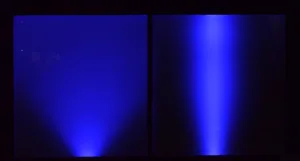Last week I, along with three other media/analyst types, was LG Display’s guest in Seoul and Paju for a tour of facilities and interviews with executives. There is a lot to share from that trip, but in this Display Daily I want to focus on only one thing: a display artifact in Samsung’s Q Series of quantum-dot LCD-TVs previously unknown to me and my colleague Pete Putman, who was also on the tour.

LGD and Samsung are in a pitched battle to convince consumers (and the media) as to whether the Q Series or LGD’s OLED-TV offer the superior image, so the Q Series is what LGD focused on in the darkened lab in LGD’s huge Paju panel manufacturing complex. But, as you will see, it is likely that the artifact would be seen on any LCD-TV that uses edge-lighting and one-dimensional (1D) local area dimming. The Q Series uses such a system, with the LEDs distributed along the bottom edge.
Photos were not permitted in the lab, but the concept of 1D dimming is shown in this photograph taken in the Corning booth at the most recent SID Display Week.
These images were shown by Corning at Display Week to demonstrate how the better local dimming index of Iris glass produces a better defined LED beam (right) for more effective 1D local area dimming. The contours of such beams should not be visible in the TV image seen by the viewer, but they were strongly suggested the “halation pattern” described in the article. (Photo: Ken Werner)
Each local dimming zone is the vertical beam of light emanating from the LED on the bottom. The artifact was demonstrated by an image of a bright moon in a star-filled black sky. The LED for the zone containing the moon brightened in order to produce the desired high luminance for the moon, but in doing so it made all of the stars within the beam brighter, and created the appearance of the sky within this zone being less black. If the moon moves across the screen, so does this “searchlight beam,” which all of us were soon calling a “halo” or “halation.” The effect was obvious and not-at-all subtle. The effect can arise whenever there is an array of bright points on the screen combined with a larger or brighter object, or even if the distribution of points is significantly uneven.
Although this effect is likely to be most disturbing to buyers of expensive premium LCD-TVs, there is no reason to think that the artifact is caused by quantum dots. It should be visible on any edge-lit LCD-TV. But, ironically, because less expensive sets are likely to have a lower “local area index” — see the left side of the photo — the local-area dimming will less effective and the artifact should be less obvious.
The artifact could be removed by using two-dimensional (2D) dimming implemented with a full-array backlight. With this type of backlight, the LEDs are arrayed evenly behind the LCD in a backlighting rather than edge-lighting configuration. Less expensive sets use a relatively small number of LEDs, resulting in low cost and less effective local dimming. Expensive sets use a large number of LEDs for excellent results at a higher cost. (Reasonably well populated full-array backlights can have their own artifacts, but the ones I’ve seen are considerably more subtle than the halation I saw at Paju.)
So why not used the full array? I have not discussed this with Samsung specifically but full-array backlights, although thinner than they used to be, are considerable thincker than edge-lights, particular those thinner versions implemented with Corning’s Iris glass instead of acrylic. And, if you go for quality rather than economy, they require more LEDs and therefore cost more.
Isn’t a full-array backlight’s modest increase in thickness worth while if it permits images with fewer artifacts? For many readers of Display Daily, the answer is probably yes. But to the marketing imagination “thin” equals “quality,” and when your competition includes an OLED-TV so thin and light it can be mounted directly on a wall, deciding to go thicker is likely not an easy call. – Ken Werner
Ken Werner is Principal of Nutmeg Consultants, specializing in the display industry, manufacturing, technology, and applications, including mobile devices and television. He consults for attorneys, investment analysts, and companies re-positioning themselves within the display industry or using displays in their products. He is the 2017 recipient of the Society for Information Display’s Lewis and Beatrice Winner Award. You can reach him at [email protected].

